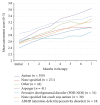Environmental Enrichment Therapy for Autism: Outcomes with Increased Access
- PMID: 27721995
- PMCID: PMC5046013
- DOI: 10.1155/2016/2734915
Environmental Enrichment Therapy for Autism: Outcomes with Increased Access
Abstract
We have previously shown in two randomized clinical trials that environmental enrichment is capable of ameliorating symptoms of autism spectrum disorder (ASD), and in the present study, we determined whether this therapy could be effective under real-world circumstances. 1,002 children were given daily Sensory Enrichment Therapy, by their parents, using personalized therapy instructions given over the Internet. Parents were asked to assess the symptoms of their child every 2 weeks for up to 7 months. An intention-to-treat analysis showed significant overall gains for a wide range of symptoms in these children, including learning, memory, anxiety, attention span, motor skills, eating, sleeping, sensory processing, self-awareness, communication, social skills, and mood/autism behaviors. The children of compliant caregivers were more likely to experience a significant improvement in their symptoms. The treatment was effective across a wide age range and there was equal progress reported for males and females, for USA and international subjects, for those who paid and those who did not pay for the therapy, and for individuals at all levels of initial symptom severity. Environmental enrichment, delivered via an online system, therefore appears to be an effective, low-cost means of treating the symptoms of ASD.
Conflict of interest statement
Eyal Aronoff is a founder and the majority shareholder of Mendability, LLC, which funded this project, and Robert Hillyer is an employee of Mendability, LLC. Michael Leon is an independent researcher with no financial ties to Mendability.
Figures








References
-
- Zablotsky B., Black L. I., Maenner M. J., Schieve L. A., Blumberg S. J. Estimated prevalence of autism and other developmental disabilities following questionnaire; Changes in the 2014 National Health Interview Survey. National Health Statistics Report. 2015;87:1–20. - PubMed
Publication types
MeSH terms
LinkOut - more resources
Full Text Sources
Other Literature Sources
Medical

